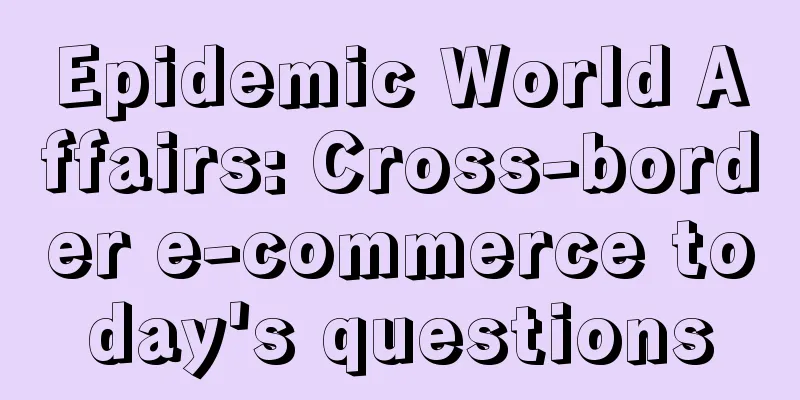|
▶ Video account attention cross-border navigation In human life, competitiveness is something of great significance. But as Marshall said: competition can be constructive or destructive. Healthy competition promotes development, while vicious competition easily leads to mutual destruction.
On Amazon, sellers are also bound to compete with each other. Among them, malicious competition incidents such as exploiting Amazon loopholes and synchronizing ASIN to obtain reviews are also emerging one after another, and sellers are simply unable to defend themselves. Just recently, we learned that many sellers reported that their products had received malicious complaints from the same person, resulting in the links being removed from the shelves. Suspected of being a repeat offender of trademark complaints? A large number of sellers have been maliciously complained! It is learned that recently many sellers on the forum reported that many products were counterfeit and infringed by complaints from shil*@gmail.com, resulting in the links being removed from the shelves: "The store received complaints of trademark infringement from shil*@gmail.com for more than a dozen listings." "Early in the morning, 33 products were removed from the shelves by this company due to complaints, all over the European site. We have our own brand." "10 products on the French site were reported as counterfeit goods without test purchase, and the listing was removed." ▲ The picture comes from Zhiwubuyan
After receiving the infringement email from Amazon, some sellers also tried to contact shil*@gmail.com, but found that the email address was set to reject receipts. ▲ The picture comes from Zhiwubuyan
Judging from the large-scale complaints and the email settings to refuse acceptance, many sellers believe that the email address is a malicious complaint, and behind it may be a service provider who makes a living by making malicious complaints. We also learned that in addition to complaints about products without trademarks, some sellers' products that have registered trademarks and patents have also received complaints and had their links removed. ▲ The picture comes from Zhiwubuyan After investigation by the seller, it was found that the trademark complained by the email was Closh*** , which belonged to a person with the Chinese name chenxiao*** . A seller said that he went to the European Union Intellectual Property Office and the United States Trademark Office to make inquiries respectively, and found that a number of trademarks were registered under the name of chenxiao***, including those in the United States and the European Union. ▲ The picture comes from Zhiwubuyan
It is also learned that, as of now, the victimized sellers who have been maliciously complained about are all sellers from European sites, including Italy, Germany, Spain, France, etc. Judging from the feedback from the sellers, no seller has been able to contact chenxiao***, who filed the trademark complaint. The purpose of his large-scale infringement complaint is still unclear. We will continue to pay attention to the subsequent development of this incident. For sellers who have been complained of infringement, the most important thing at the moment is to file a complaint as soon as possible. ▲ The picture comes from Weibo Combined with the sellers' comments, the following steps are summarized to deal with infringement complaints: Step 1 : Check the specific content of the infringing email to see what specific infringement the email notification is about. Step 2 : Check whether there is real infringement. If the product is really infringing, you can go through the settlement process and contact the copyright owner, so there is no need for the third step. Step 3 : If you clearly conclude that there is no infringement, you can choose to: 1. Contact the property owner or third-party complaint company and ask them to provide evidence of infringement or withdraw the complaint application; 2. Submit a complaint letter to Amazon. There are a few key points to keep in mind when writing a letter of appeal: 1. Sincerely state that after receiving the complaint letter, you have clearly checked that your products are not infringing and actively contacted the copyright owner; 2. Fully understand your own products and the patents of the property rights holders, and analyze the differences between the two ; 3. Do not waste any opportunity to appeal , and be careful and thorough when writing the appeal letter. Step 4 : After receiving Amazon’s response to the appeal letter, carefully follow Amazon’s requirements. The above are a few steps mentioned by sellers on how to deal with infringement complaints. Competition is inevitable when selling on Amazon. However, the competition that the cross-border e-commerce market really needs is benign and well-intentioned. Vicious competition will only encourage bad market trends. Sellers who rely on temporary illegal means to gain a slight advantage will not be the real winners in the end. In addition, as we all know, Amazon has always attached great importance to the protection of sellers' intellectual property rights. In recent years, with the rapid development of the export cross-border e-commerce industry, the brand value of enterprises has become more prominent, and Chinese sellers have also attached more importance to brand building. We also learned that in addition to a large number of sellers receiving malicious counterfeit infringement complaints, which led to the removal of links, the topic of Amazon's whitelist expiration has also attracted much attention from sellers recently. Suspected to be affected by system update? Amazon whitelist invalid! We learned that recently in the seller communication group, many sellers reported that due to the update of Amazon system, all brand whitelists have become invalid and need to be re-applied.
▲ The picture comes from the seller communication group There are even related service providers who said that due to changes in Amazon policies, the whitelisting previously made may trigger a second review. ▲ The picture comes from the seller communication group It is learned that the so-called Amazon brand whitelist is mainly a channel for sellers who already have TM marks but cannot upload products. It can allow many sellers who have not done brand registration to get rid of the problem of not being able to upload products when creating new listings. At the end of 2019, Amazon updated its brand policy, requiring that the attribute of unbranded products should be "N/A". In order to avoid the risk of infringement, many unbranded sellers chose to apply for the brand whitelist to solve the problem of filling in the unbranded information when creating new listings. In response to the recent issue of Amazon whitelist expiration, the steps to reapply for the whitelist are summarized here for sellers in need: 1. Decide on a trademark name. Check in advance on major intellectual property websites or find a trademark registration agent to make sure that the brand trademark has not been registered to avoid infringement risks; 2. Upload the listing and get the "5566" error notification, and take a screenshot and save it for future use in opening a case; 3. Prepare pictures of products and packaging that meet the standards- The brand name used when creating the product listing should match the branding on the product and/or packaging. Always include the branding.
- Images of the product and packaging showing the brand on both. Images may show the product and packaging held in hand or placed on a table, and the brand must be permanently affixed.
4. Open a case to explain the "5566" error when uploading the listing, and provide a screenshot of the error. After preparing all the information, find the corresponding case on the "Problem Log" page, reply and submit the information. 5. If there is no problem with the submitted information, you will generally receive an email notifying you of the review results within 3-5 working days. Finally, we also recommend that sellers check whether the product has been registered before selecting it, so as to avoid huge losses caused by listing removal or prosecution due to infringement. In addition, it is also important to apply for branding for your own products first to prevent this situation.
In addition, it is also learned that at a regular press conference held by the Ministry of Commerce recently, the Ministry of Commerce stated that with the rapid development of new formats, the policy environment is also constantly optimizing, and relevant departments are studying policy measures including facilitating cross-border e-commerce export returns and exchanges . These policies will help promote the healthy and sustainable innovative development of cross-border e-commerce and help stabilize and improve the quality of foreign trade. With the help of favorable cross-border policies, Chinese cross-border sellers are gradually shifting from building price advantages to building brand advantages. We also believe that in the future, more high-quality Chinese brands will go global. What do you think about this? Welcome to discuss in the comment area~ |










